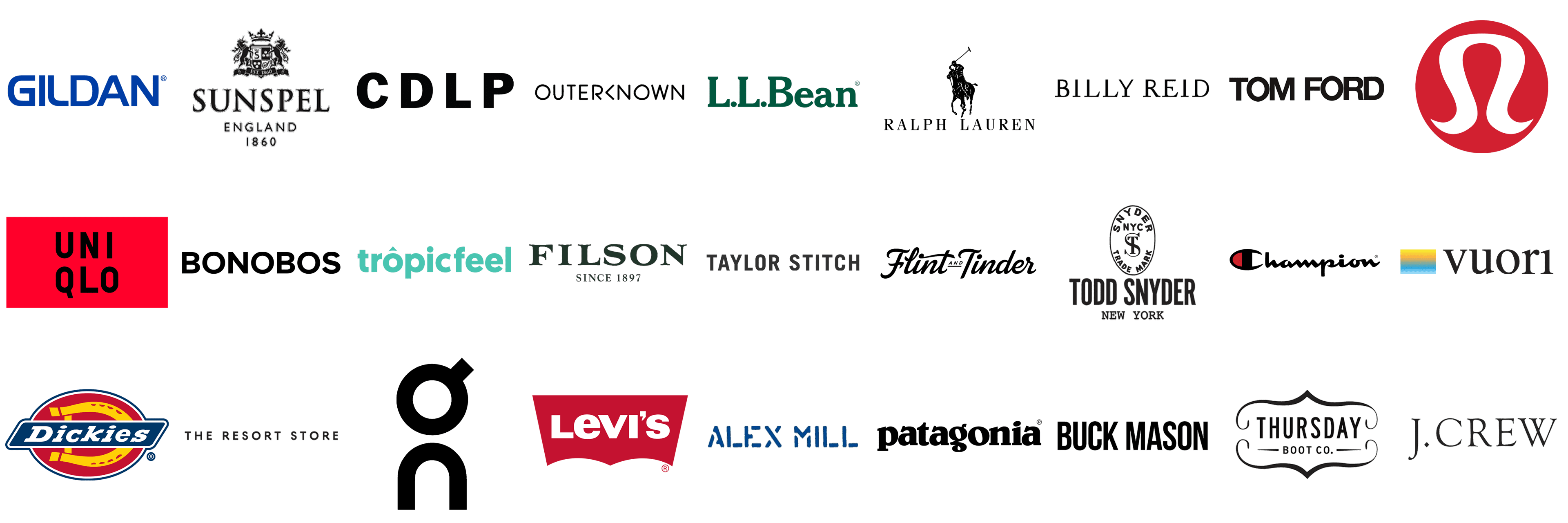A Guide to Choosing Weather-Appropriate Branded Clothing Materials
A Guide to Choosing Weather-Appropriate Branded Clothing Materials
Blog Article
The Value of Sustainable Clothes: How It Affects the Atmosphere and Your Wardrobe
Sustainable clothes is increasingly identified for its critical function in lessening the ecological influence of the quick garment industry. By concentrating on environmentally friendly materials and honest production techniques, it addresses pressing environmental problems. This change not just profits the earth yet additionally affects customer selections, leading to an extra thoughtful technique to wardrobe administration. Comprehending these dynamics elevates important inquiries concerning fashion's future and personal duty in shaping it.
The Ecological Impact of Fast Style

Advantages of Lasting Materials
Lasting products use considerable benefits, especially through green fabric selections that reduce environmental harm. These products additionally show resilience and longevity, reducing the demand for constant replacements. Therefore, they contribute to an extra sustainable fashion business and advertise accountable consumer actions.
Eco-Friendly Textile Selections
While the fashion business has long been related to fast trends and ecological damage, the increase of environment-friendly material options offers a transformative chance. Sustainable materials such as organic cotton, hemp, and Tencel have gotten popularity as a result of their lower ecological influence. These textiles are commonly created without damaging pesticides and need less water, minimizing their carbon footprint - Branded Clothing. Additionally, numerous environment-friendly materials are naturally degradable, adding to a circular economy by decreasing waste. Picking lasting products not just sustains ecologically accountable practices however likewise advertises healthier environments. As consumers end up being much more knowledgeable about their acquiring power, the need for eco-friendly textiles encourages brands to introduce and take on even more lasting manufacturing approaches, ultimately profiting the world and future generations
Longevity and Long Life Advantages
Many consumers are significantly recognizing the sturdiness and longevity benefits of lasting materials in their garments options. Unlike traditional fabrics, sustainable products such as natural cotton, hemp, and recycled polyester are engineered to stand up to damage, causing garments that last much longer. This reduced frequency of substitute not only saves customers money over time but additionally decreases waste created by rapid style. Additionally, sustainable clothes often uses green production approaches that improve fabric stamina, contributing to a decrease in the overall carbon impact. By purchasing durable apparel, customers can grow a much more lasting wardrobe while taking pleasure in top quality pieces that keep their aesthetic and capability with time. Resilience and durability stand as vital advantages of picking lasting materials.
Decreasing Waste With Sustainable Practices
Minimizing waste in the apparel industry can be attained via cutting-edge practices such as upcycling and repurposing materials. Additionally, embracing minimal closet techniques urges consumers to focus on top quality over amount, eventually decreasing clothes consumption. With each other, these methods contribute considerably to a much more sustainable apparel version.
Upcycling and Repurposing Products
Upcycling and repurposing materials have emerged as innovative strategies in the style sector, transforming discarded textiles right into important brand-new items. This method not just decreases waste however additionally urges creative thinking and individuality in clothing style. By taking old garments and materials, designers can develop unique pieces that reflect individual style while decreasing the demand for new resources. Additionally, upcycling commonly requires less power and water compared to traditional production procedures, considerably reducing the ecological impact of style. As customers end up being much more knowledgeable about sustainability, the popularity of upcycled clothing proceeds to climb, promoting a round economic climate. Inevitably, these techniques add to an extra lasting future, where style focuses on ecological wellness over fast manufacturing and consumption.

Minimal Closet Methods
As individuals significantly seek to minimize their environmental impact, embracing minimalist closet techniques has actually gained traction as a reliable technique to sustainable style. These strategies emphasize quality over amount, motivating customers to curate a smaller collection of flexible, durable apparel. By concentrating on classic pieces that can be combined and matched, people can lower the frequency of purchases and inevitably lower waste.Additionally, minimalism promotes mindful intake, urging consumers to review the environmental and moral ramifications of their selections. This method not only cultivates a much more sustainable lifestyle yet also simplifies everyday decision-making relating to clothing. As individuals accept minimalist concepts, they add to a style society that values sustainability and liable consumerism, inevitably causing a more eco-conscious society.
The Role of Moral Labor in Lasting Style
While numerous customers are increasingly knowledgeable about the ecological effects of their apparel options, the relevance of honest labor practices in lasting style can not be overlooked. Honest labor incorporates reasonable wages, risk-free working conditions, and respect for workers' rights, creating the foundation of responsible style manufacturing. Brand names that focus on honest labor not only uplift communities however also set a standard for responsibility in the industry.Moreover, the combination of moral methods fosters transparency, allowing customers to make informed choices concerning their purchases. This method contrasts greatly with quick style's unscrupulous labor models, which typically focus on earnings over individuals. By sustaining business dedicated to ethical labor, consumers add to a system that values human dignity along with ecological sustainability. Honest labor is not merely an add-on; it is necessary to the broader objective of lasting style, making certain that the mission for eco-friendliness does not come at the expenditure of human civil liberties.
The Effect of Lasting Clothing on Carbon Emissions
Lasting garments has the potential to greatly decrease carbon exhausts associated with the apparel industry. Conventional garment manufacturing contributes notably to greenhouse gas discharges, primarily as a result of energy-intensive production processes and the use of non-renewable resources. On the other hand, sustainable fashion concentrates on eco-friendly materials, such as natural cotton or recycled fibers, which often require much less energy to produce.Moreover, lasting brand names tend to take on more reliable manufacturing methods, minimizing waste and lowering general discharges. By focusing on toughness and timeless style, lasting clothing urges customers to purchase much less often, additional minimizing the carbon impact related to overconsumption.Additionally, lots of sustainable brand names are committed to transparency in their supply chains, making it possible for customers to make enlightened choices that line up with their worths. Ultimately, shifting in the direction of lasting apparel can bring about a significant reduction in carbon exhausts, adding to a much healthier world and an go to website extra lasting future for the garment industry.
Sustaining Local Economic Situations With Sustainable Choices
The change toward lasting clothing not only addresses ecological worries yet also considerably advantages regional economies. By selecting lasting style, customers commonly sustain local craftsmens and tiny businesses, boosting community resilience. These enterprises generally run on a smaller sized range, focusing on craftsmanship and honest techniques over mass production.Investing in locally made lasting clothes promotes work creation and stimulates financial growth within communities. As customers become much more aware of the ecological effect of their acquisitions, they increasingly seek out products that reflect their values. This demand motivates regional manufacturers to take on sustainable practices, adding to a round economy.Moreover, sustaining neighborhood businesses reduces transport emissions, straightening with eco-conscious customer habits. The interconnectedness of lasting clothes and regional economies emphasizes the necessary function that specific selections play in promoting both financial and ecological wellness. By promoting these regional connections, communities can thrive while also working in the direction of an extra lasting future.
Transforming Your Closet: Tips for a Lasting Closet
As individuals seek to lower their ecological effect, changing a wardrobe into a lasting wardrobe ends up being an important action. One effective method is to examine existing apparel, keeping only items that are worn regularly which straighten with sustainability objectives. Prioritizing high quality over quantity is crucial; purchasing sturdy pieces from environment-friendly brand names can significantly lower waste.Additionally, incorporating second-hand products can rejuvenate a closet while lessening environmental damages. Organizing apparel swaps with pals or contributing unused items can further promote sustainability.When shopping, people must look for materials that are organic, recycled, or naturally degradable, and prevent quick fashion merchants - Branded Clothing. Exercising conscious consumption by thoughtfully thinking about each acquisition can contribute to an extra lasting way of living. By carrying out these ideas, one can create a closet that mirrors personal style while sustaining environmental stewardship
Regularly Asked Questions
How Can I Identify Lasting Clothing Brands?
To identify sustainable clothes brand names, one ought to investigate products utilized, check for qualifications like Fair Trade, and take a look at the brand name's openness regarding their Check Out Your URL manufacturing processes, labor methods, and environmental impact, guaranteeing environment-friendly and moral practices are focused on.
What Are the Expenses Related To Lasting Fashion?
The costs related to lasting style can vary substantially. Greater production expenses, honest sourcing, and eco-friendly products often bring about boosted market prices, which might discourage some consumers while appealing to eco mindful buyers.
Can Lasting Clothing Be Stylish and Fashionable?
Lasting garments can without a doubt be fashionable and trendy. Designers significantly focus on innovative products and honest production approaches, showing that style and sustainability can exist find out here now together. Customers now have varied options that blend aesthetic appeals with environmental consciousness.
Just How Does Washing Garments Affect Their Sustainability?
Washing clothing substantially impacts sustainability by consuming water and power, contributing to air pollution, and causing microplastic launch. Frequent cleaning can deteriorate textiles, shortening their life expectancy and increasing the need for replacements, ultimately intensifying ecological problems.
What Is the Life-span of Sustainable Garments Compared to Fast Style?
The life expectancy of lasting clothes generally goes beyond that of rapid fashion products, often long-term several years as a result of top quality products and craftsmanship. In contrast, rapid style garments may deteriorate quickly, demanding even more frequent replacements. Lasting apparel is progressively acknowledged for its crucial function in reducing the environmental impact of the quick style market. While lots of customers are significantly mindful of the environmental effects of their apparel choices, the significance of moral labor methods in sustainable style can not be forgotten. Branded Clothing. Sustainable clothing has the prospective to considerably minimize carbon emissions associated with the style sector. In contrast, lasting fashion concentrates on eco-friendly products, such as organic cotton or recycled fibers, which often require less energy to produce.Moreover, lasting brands have a tendency to embrace more reliable production methods, minimizing waste and lowering general exhausts. By focusing on longevity and timeless style, sustainable garments motivates consumers to buy much less frequently, further reducing the carbon impact linked with overconsumption.Additionally, lots of lasting brands are devoted to transparency in their supply chains, allowing customers to make educated options that align with their worths
Report this page